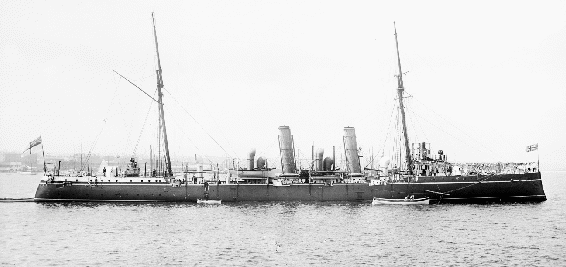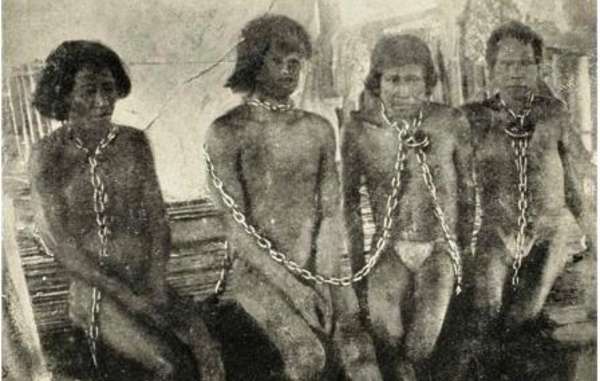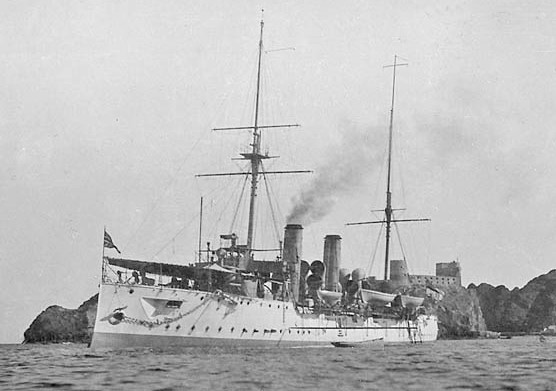HMS Pelorus 1909:
A British cruiser 2000 miles up the Amazon
As a prisoner on HMS Bellerophon, prior to his exile on St. Helena, Napoleon told its commander, Captain Maitland, that, “If it had not been for you English, I should have been Emperor of the East; but wherever there is water to float a ship, we are sure to find you in our way.” This ability was to manifest itself on numerous occasions up to the middle of the next century. Small Royal Navy units were to operate in China on the Upper Yangtze, on Lake Tanganyika and on the Nile in the Sudan, in the Caspian Sea and on remote Russian rivers during the Russian Civil War and they were to reach Vienna, some 800 miles up the Danube from the Black Sea at the end of World War 1. More impressive of all these achievements was however that, not of a small gunboat, but of a cruiser of over 2000 tons that reached Peru in 1909. This does not perhaps seem remarkable – Peru has a long coast on the Pacific Ocean – until it is realised that the approach was from the east, up the Amazon River, almost to its headwaters.
 HMS Pelorous in late 1890s – resplendent in “Victorian Livery of black hull, white upperworks and buff funnel
HMS Pelorous in late 1890s – resplendent in “Victorian Livery of black hull, white upperworks and buff funnel
Launched in 1896, the name ship of a class of eleven, HMS Pelorus was a third-class protected cruiser. “Protected” meant that the vessel’s sides were not armoured but that an arched armoured deck protected the boilers, engines and other vital areas. “Third Class” implied a small vessel, suited to commerce-protection duties, or for scouting for larger units. Pelorus and her ten sisters were 2135-ton, 300-feet long vessels and their 7000-hp gave them a top speed of 20 knots. Crewed by 224 men, their main armament consisted of eight 4-inch breech loading guns for anti-ship use, supplemented by eight 3-pounder quick-firing weapons for defence against attack by torpedo boats. They also carried two 18-inch torpedo tubes.

Kipling in the 1890s
HMS Pelorus served almost ten years in the “Channel Fleet” – that tasked with operations in the North Atlantic and the North Sea but in 1906 she was posed to the Cape of Good Hope Station. Although only a small unit in a navy made up of hundreds of ships, she had already achieved fame through a series of articles published in the Morning Post newspaper, and subsequently gathered into a small book entitled “A Fleet in Being”. The author was the writer and poet Rudyard Kipling, who was a friend of a Captain E.H. Bayley, who was then commanding HMS Pelorus. In 1897, as a guest of Bayly, Kipling was on board HMS Pelorus for two weeks during the Fleet’s summer exercises and he was to repeat the experience the following year. His writings about his time on HMS Pelorus give fascinating insights into shipboard naval life in the late nineteenth-century. There if however a strong impression of forced enthusiasm, of determination to see everything through rose-tinted glasses, and to give an epic quality to what were, in reality, peacetime manoeuvres. As with much of Kipling’s writings the treatment of individuals is condescending and patronising, and leaves a sour taste with at least one modern reader.
 Manaus Opera House – best known symbol of the Amazon rubber boom
Manaus Opera House – best known symbol of the Amazon rubber boom
(photograph by Pontanegra via Wikipedia)
In 1909 the “Rubber Boom” in Brazil and Peru was in full swing. The rubber in question grew wild in the forests lining the Amazon and its tributaries as plantation-cultivation of rubber in Malaya had not yet taken off on the large scale it was to become. The arrival of the automobile had pushed the demand for rubber to unprecedented levels and fortunes were made by anybody who could organise its collection from trees growing wild in the forest. This was the era when the city of Manaus was to build its exotic opera house at the confluence of the Amazon and the Rio Negro, the period immortalised in Werner Herzog’s stunning movie “Fitzcaraldo”. British commercial firms were active in the trade and it was only by the investigations in 1910 and 1911 of a British consul, Roger Casement, that the true nature of their activities was revealed.
 Enslaved Peruvian Indians during the rubber boom
Enslaved Peruvian Indians during the rubber boom
In the Putomayo area of north-eastern Peru Casement found that indigenous tribes were begin forced into unpaid labour – essentially slavery – to collect the forest rubber. Abuse of these innocent people included starvation-level feeding, physical abuse, rape of women and girls, branding and casual murder. The chief offender was the Peruvian Amazon Company (PAC), which had been registered in Britain in 1908 and had a British board of directors and numerous stockholders. Casement’s report aroused public outrage in Britain but what in the end brought a complete end to the abuses was the arrival of cheaper, plantation-grown rubber from Malaya that made wild-rubber collection economically unattractive. (Casement was to be knighted for the exposure of these abuses, and of similar atrocities in the Congo. His career was to end in hanging in 1916 as an Irish Republican working closely with Imperial Germany).
 Pelorus’s 200-mile route up the Amazon
Pelorus’s 200-mile route up the Amazon
Casement’s uncovering of the realities of the rubber trade were still a year and more in the future when, in February 1909, HMS Pelorus arrived in the eastern Peruvian town of Iquitos, on the upper reaches of the Amazon. The objective of this good-will visit was to help promotion of British exports to Peru as the rubber boom had created an enormous demand for goods from the industrialised world. The arrival of a sophisticated warship was ample proof of similarly sized, or smaller, steamships, being well capable of following the same route. The achievement was a spectacular one – HMS Pelorus had navigated some 2000 miles of winding, often forest-lined, river from the river’s estuary on the South Atlantic coast. On arrival at Iquitos the nearer ocean was the Pacific, a mere 600 miles away, but with the Andes mountain range lying between. Despite its isolation, Iquitos, a town of 30,000, boasted electric lighting, tramways, a theatre and, apparently, a cinema. ( A vivir impression of the town in this era is given in Werner Herzog’s “Fitzcarrqldo”). The seven-day visit by HMS Pelorous followed the usual pattern for such “showing the flag” missions – dinners, speeches, an open day for the public, a football match, a concert and a “cinematograph show”. (One wonders what was shown at the latter.)

HMS Perseus, sister of HMS Pelorous, in tropical livery of white hull and ochre funnels. On her Amazon voyage HMS Pelorus was likely to be similarly painted. (Background suggests to Antoine Vanner that this photograph was taken at Muscat)
HMS Pelorus needed to replenish her bunkers before embarking on the return trip. Remarkably, she was to do so with Welsh coal which was apparently a normal import to the area from Britain for use on river craft. The costs of its transportation raised the price to more than four times its British level. With congratulations, well-wishes and handshakes all round, HMS Pelorus then commenced her voyage homewards, docking at Manaus and Belem en route to the Atlantic. She spent six-weeks in total on the Amazon and was a matter of pride for both captain and crew that the river passage had been a healthy one, with minimum sickness and, despite the prevalence of mosquitoes and insects, no cases of fever.

HMS Pryamus, sister of HMS Pelorous, in dull grey in 1914.
The Amazon voyage was HMS Pelorus’s last moment in the limelight. By the time of outbreak of war in 1914 she and the few of her sisters still in service were old, obsolete ships suited only to secondary duties. She was scrapped in 1920.
One wonders if the Indians in the Putomayo area, north of Iquitos, who laboured in slavery for the London-based Peruvian Amazon Company, ever heard of the visit. Even if they did it is unlikely that they would have been able to go on board during HMS Pelorus’s open day.
s
 1866: it’s four years since France invaded Mexico and set up a new ‘Mexican Empire’ with a puppet emperor imported from Europe but armies loyal to the republican government still resist. In a land devastated by battles, atrocities and reprisals, the tide of war is now turning in favour of the republic’s ‘Juarista’ supporters. France recognises that the war is unwinnable and evacuation inevitable, but first there will be bitter rearguard actions and old scores to settle.
1866: it’s four years since France invaded Mexico and set up a new ‘Mexican Empire’ with a puppet emperor imported from Europe but armies loyal to the republican government still resist. In a land devastated by battles, atrocities and reprisals, the tide of war is now turning in favour of the republic’s ‘Juarista’ supporters. France recognises that the war is unwinnable and evacuation inevitable, but first there will be bitter rearguard actions and old scores to settle.
Britain is neutral in this conflict, but large British interests – railway and mining enterprises – are at risk as the war-front edges ever closer. Investors in London are demanding British action to protect their assets.
Sub-Lieutenant Nicholas Dawlish is serving on the Pacific Station in the gunvessel HMS Sprightly. She, and her resourceful captain, are tasked with taking ‘appropriate’ action to guarantee the safety of these interests. The situation is complex – not only Juarista, French and Imperial Mexican forces but bandit groups, a volunteer Belgian Legion and ex-Confederate mercenaries are involved. And there’s a powerful ironclad, flying Imperial Mexican colours, commanded by an Austrian aristocrat who’s desperate for glory.
Dawlish is plunged into deadly action by land and sea and, with fluency in French and Spanish, he’ll be his captain’s right-hand man in a web of political intrigue, treachery and greed in which a single mistake can end both their careers.
But for Dawlish there’s something worse, a heart-breaking encounter with a figure from his past to whom he’s linked by a solemn promise that he can’t fulfill. What follows will be torment for his emotions and his conscience . . .
Available in Large Paperback and Kindle formats. Kindle Unlimited subscribers can read at no extra charge. Kindle version available for pre-order. Click the marketplaces below for ordering details:
United States Canada
United Kingdom Australia & New Zealand
Below are the twelve Dawlish Chronicles novels published to date, shown in chronological order. All can be read as “stand-alones”. Click on the covers below for more information. All are available in Paperback or Kindle format and can be read at no extra charge by Kindle Unlimited Subscribers.
Six free short-stories are available for download to your Kindle. Access them by registering for the Dawlish Chronicles mailing list – just click on the banner below. You’ll be kept updated on new books and will receive other free stories at intervals.





